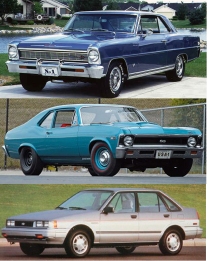It occurred to me while thinking about the upcoming Alfa return to the U.S., I’m curious about what Alfa owners think about the sort of bastardization of later models. Then I recognized a trend that rings through much of the automotive landscape.
Starting with Alfa, when once the Giulietta was a classic sedan that helped as a staple of sport-sedan lore, and the GTV being the racer-coupe… now it’s a stylish but nevertheless FWD/AWD hatchback that underpins the Dodge Dart (more on that later).
In the 1990’s, the GTV6 went from being F/R with that rear-mounted transaxle and inboard rear brakes, and turned into a somewhat clunky looking (to me, anyway) front-drive coupe.


For that whole Alfa Romeo Giulietta/Dodge Dart, die-hard Mopar fans keep bashing the Dart because of the “muscle-car” heritage… they seem to forget the Dart was the economy car equivalent of the Dodge line. Those beloved GT’s and RT’s stuffed with V8’s were the Dart’s version of what Volkswagen does with the Golf: GT’s (a Europe thing), GTi’s, R’s, and so on. the base Dart’s were just any other boring old tool that people paid little attention to when they were out.



The new Dart GT next to some of the old models
There is still a lack of consideration for the names that used to mean more. In the Dodge Dart’s case, Neon would have been fine by most people. Similar antics are seen with GM and Toyota: the Corolla used to have some hot variants that to this day are immortalized to the point of wanting to yell “shut up about the AE86 already!,” or Chevy throwing the Nova name on the very same Corolla that began the decline of the aforementioned lineage of AE86’s and their rear-drive predecessors.


At first I was like… then I was like…. Corolla/Nova de-volutions. Note the last Nova was based on the same Corolla platform that ruined that rear-driven lineage.
Another case of name having more weight then we realize was evident around the 2007 model year, but lets step back a couple years. In 2005, Ford came out with the large Volvo-based sedan named Five Hundred (spelled out– get it right). That car wasn’t a very big seller in part because of its lack of power– 200hp/208lbft in a two-ton sedan that could pack all-wheel drive isn’t quick. Come 2007 there were new lights, a new engine (up to 263hp now– yay!), but also a new name while in the middle of its debut. They went from the Ford Fivehundred to the Ford Taurus– long a good seller for Ford. While that re-named car didn’t sell much better under the Taurus name, the more intense refresh (still the same platform) has sold well with a more modern shape inside and out… the modern Taurus just doesn’t feel roomy with the closed in turret windows.
One has to wonder what a name is for a car or a company. There are countless examples of a company pulling up roots of the enthusiast and what they come to love, and turning it instead into a cash cow. Sometimes they recognize their foibles and try to revert to once was (the Mustang, Camaro, and Challenger all made good comebacks), while others still sit in a land of commuting boxes. The Corolla was never intended to become that rear-driven legend, but enthusiasts tapped their classic potential the same way hot-rodders predated factory muscle cars. Looking at the Corolla now, for example, there’s less light at the end of the tunnel. But hey, what’s in a name?






